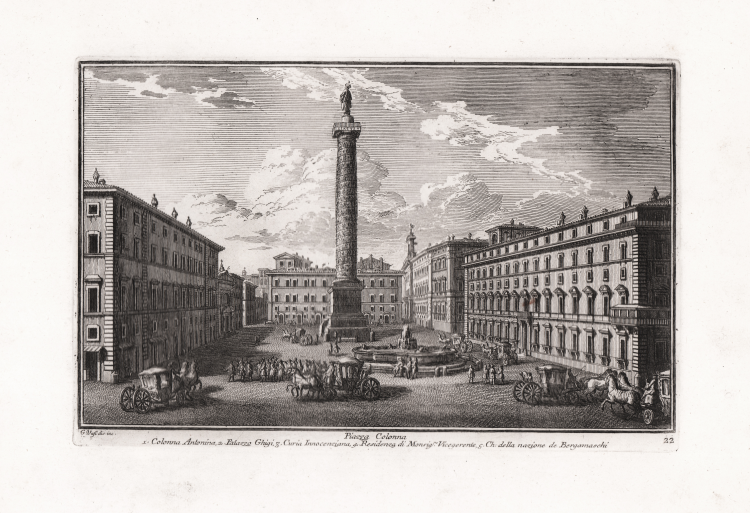



| Reference: | S44131 |
| Author | Giuseppe VASI |
| Year: | 1752 |
| Zone: | Piazza Colonna |
| Printed: | Rome |
| Measures: | 325 x 214 mm |


| Reference: | S44131 |
| Author | Giuseppe VASI |
| Year: | 1752 |
| Zone: | Piazza Colonna |
| Printed: | Rome |
| Measures: | 325 x 214 mm |
Famous as the "maestro" of Giovanni Battista Piranesi, Giuseppe Vasi reveals in this monumental work his graphic inventivness. The "Magnificenze" (divided into 10 volumes printed between 1747 and 1762) provide an uncommon and complete view of the city of Rome: therefore, together with the famous and common views of the tradition, there is also an unusual Rome which, somethimes, doesn't exist any more.
In the description below the plate Vasi made reference to: 1. Colonna Antonina, 2. Palazzo Ghigi, 3. Curia Innocenziana, 4. Residenza di Monsig. Vicegerente, 5. Chiesa della nazione de Bergamaschi.
Copper engraving in excellent condition.
|
Scalabroni, 89
|
Giuseppe VASI (Corleone, 27 Agosto 1710 - Roma, 16 Aprile 1782)
|
Italian engraver and painter. After completing a classical education, he trained as a printmaker in Palermo, possibly at the Collegio Carolino, which was founded by the Jesuit Order in 1728 and at which the etcher Francesco Ciché ( fl before 1707; d Palermo, 1742) was a teacher. Vasi was already an accomplished engraver when, in 1736, he contributed to the illustration of La reggia in trionfo by Pietro La Placa, which described the festivities held in Palermo to mark the coronation of Charles VII of Naples (the future Charles III of Spain). That same year Vasi moved to Rome, where, as a Neapolitan subject, he was immediately afforded the protection of the ambassador, Cardinal Troiano Aquaviva d’Aragona (1694–1747). In Rome he met other artists who worked for the same patron: Sebastiano Conca, Luigi Vanvitelli and Ferdinando Fuga. It is against this background that Vasi’s work in Rome, when he was in residence at the Palazzo Farnese, should be considered: his monopoly as the engraver of the Roman records of the monarch, the plates for the festivals of the ‘Chinea’ and the triumphal arches erected in front of the Palatine gardens on the occasion of temporal sovereignty over Rome
|
|
Scalabroni, 89
|
Giuseppe VASI (Corleone, 27 Agosto 1710 - Roma, 16 Aprile 1782)
|
Italian engraver and painter. After completing a classical education, he trained as a printmaker in Palermo, possibly at the Collegio Carolino, which was founded by the Jesuit Order in 1728 and at which the etcher Francesco Ciché ( fl before 1707; d Palermo, 1742) was a teacher. Vasi was already an accomplished engraver when, in 1736, he contributed to the illustration of La reggia in trionfo by Pietro La Placa, which described the festivities held in Palermo to mark the coronation of Charles VII of Naples (the future Charles III of Spain). That same year Vasi moved to Rome, where, as a Neapolitan subject, he was immediately afforded the protection of the ambassador, Cardinal Troiano Aquaviva d’Aragona (1694–1747). In Rome he met other artists who worked for the same patron: Sebastiano Conca, Luigi Vanvitelli and Ferdinando Fuga. It is against this background that Vasi’s work in Rome, when he was in residence at the Palazzo Farnese, should be considered: his monopoly as the engraver of the Roman records of the monarch, the plates for the festivals of the ‘Chinea’ and the triumphal arches erected in front of the Palatine gardens on the occasion of temporal sovereignty over Rome
|